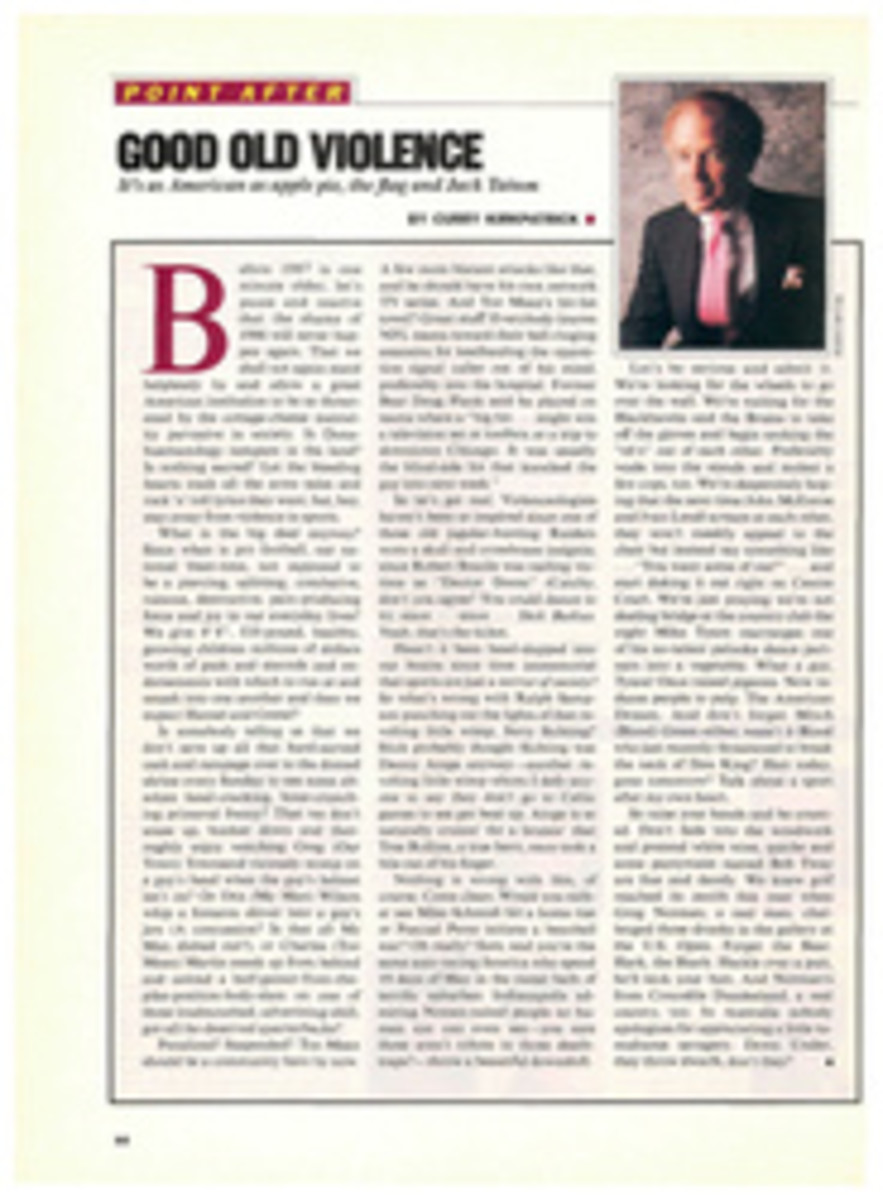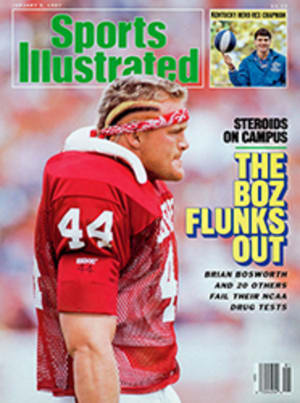
WAKE-UP CALL FOR THE JETS
Derided by their fans, humiliated by five different teams in the last five weeks, the New York Jets staggered into their AFC wild-card playoff game on Sunday and blew away the Kansas City Chiefs, 35-15. They switched starting quarterbacks, bringing in 31-year-old Pat Ryan for a worn out Ken O'Brien. They changed their defensive philosophy, getting away from an attacking style and going to a lay-back-and-wait zone. The Jets had an entirely different personality, and if you think the playoffs are a strange time to change your whole operation, you're right. But the Jets had to do it.
The reason is O'Brien's arm. It died on him in December, when the Jets were into that five-game losing streak. Maybe died is too strong. It got tired, very tired. It had two, maybe three deep throws in it per game, and that was all. The long-ball attack that had given the Jets a 10-1 record and had O'Brien sitting comfortably atop the NFL quarterback rankings with a dazzling 107.9 grade became a dim memory.
Oh, he would crank up and try to get the ball deep, just to show he could. In the next to last game of the season, a 45-24 blowout by the Steelers, he threw long twice. Both passes were intercepted. He tried three long ones in the finale, a 52-21 loss to the Bengals. Each was incomplete. There were two completions longer than 16 yards in those two games, a 17-yarder and a 24-yarder, both on patterns over the middle, which are easier on the arm. Wideouts Al Toon and Wesley Walker, who were on their way to Pro Bowl seasons, had been taken out of the attack. In the last four games halfback Freeman McNeil caught more passes than both of them combined.
O'Brien had come into camp during the summer and thrown five days a week. When he wasn't practicing on the field during the season, he was throwing on the sideline, always throwing. When the weather turned cold, the equipment man would give him a thermal shirt to wear under his jersey, but he turned it down. He was young and strong, and his arm had lightning in it. Then his arm got tired.
"Yeah, there's a lot to that," O'Brien said Sunday, as the TV men with their lights and cameras set up to interview Ryan. "It's something that's hard to understand when it's happening to you, but I'll have to look at the whole situation in the off-season, how I train, everything."
The Jets' schizophrenic turnaround, from the NFL's best team over the first 11 weeks to one of the worst during the last five, had everyone pointing to the defense. Mark Gastineau, their premier pass rusher, never was healthy. Two Pro Bowlers, noseguard Joe Klecko and inside linebacker Lance Mehl, went down in the eighth week. Two weeks later, left end Marty Lyons, who was having the best season of his career, was hurt. That must have been it—the defense was crippled, so the whole mesh was destroyed.
But it was the offense that died. The defense hadn't been solid all season. Even with Klecko, Mehl and Lyons in the lineup, at midseason the defense ranked 22nd overall and dead last against the pass. If you play shootout football, you have to outscore people. Certainly that was the kind of challenge O'Brien welcomed.
When the Dolphins' Dan Marino passed for 448 yards against the Jets on Sept. 21, O'Brien topped him with 479, including a touchdown pass on the last play in regulation time and then a 43-yard TD pass in overtime. When Seattle broke on top in the Kingdome on Nov. 2—and it looked like one of those mean, nasty games the Seahawks always win at home—the Jets responded with 21 points in the second quarter, two of the TDs coming on long passes. But then the magic stopped, and for five weeks the Jets looked like the worst team in the NFL—O.K., the second worst. Tampa Bay is in a class by itself.
The psychologists went to work. O'Brien was pressing. The strain of having to score so much had gotten to him. The first 11 games had been a mirage, a delusion. Motivation was missing; self-realization. One New York paper set a record for silliness when it hired a sports psychologist, Dr. Eric Margenau, to do a preplayoff psychological analysis of the Jets and Chiefs, based on a point scale of 1 to 10. He rated such factors as State of Mind and Team Chemistry/Effect of Injuries. In the category of No Choke/Self-Destruct, Fear of Success, the Chiefs came out on top 8.0 to 5.0.
But the simplest answer was the one that was never mentioned. The quarterback had a tired arm. The long-ball attack was gone. Jet coach Joe Walton did not refer to it in his Wednesday press conference when he announced that Ryan would be his starting QB.
"For how long?" someone asked him.
"Kenny's still our quarterback," he said.
Pat Ryan is one of those quarterbacks whose destiny is to be a backup. In nine seasons he has had 13 starts. Always competent and at times brilliant, Ryan never tries to do things he has been told he isn't capable of doing. Nimble of foot and extremely intelligent, he has the knack of keeping a drive going. The interesting thing is that when he ran the show this season—against the Patriots and the Broncos, while O'Brien was nursing a sprained knee—the team won the same way it did Sunday: with thunder on the ground against teams that were supposedly very tough against the run.
McNeil, a former Pro Bowler, pounded the left side of the Chiefs' defense, especially end Pete Koch, the weakest lineman, and Tim Cofield, the rookie outside linebacker. The idea worked out well. McNeil rushed for 135 yards as the Jets gained 165 yards on the ground, which was their highest total in 11 weeks.
But that was only half the battle. There was the matter of stopping the K.C. attack. Defensive coach Bud Carson had been fired by the Chiefs' John Mackovic before the start of the 1984 season. So the game was special to him. "Bud didn't say anything, but he didn't have to," outside linebacker Bob Crable said. "To say the game didn't have extra meaning to Bud would have been the understatement of the decade."
Still the Chiefs, with the lowest-rated offense in the NFL, marched 67 yards in nine plays for a TD on their opening drive. But that was their last serious threat. They fumbled on their first play the next time they had the ball. They were held to minus nine yards in the second quarter. The Jets put together three long drives, and at halftime the score was 21-6. The game was over. Carson, whose blitzing defense was burned by the Bengals, pulled back into a conservative type of zone. K.C.'s Todd Blackledge, starting for the injured Bill Kenney, couldn't find his receivers in the forest downfield.
So now the Jets go to Cleveland to try to get to the AFC championship game. Walton was cagey on who would be his starting quarterback, but unless O'Brien's arm recovers, it will be Ryan. Who knows? It has been a strange season for the Jets.
PHOTO
JOHN BIEVER
Barry Bennett offered Blackledge resounding proof that the Jets' defense was once again a force to be reckoned with.
PHOTO
JOHN BIEVER
Jerry Holmes went airborne with the Chiefs' Henry Marshall to knock down this pass.
PHOTO
JOHN BIEVER
Ryan (10) had himself a fine outing thanks, in part, to some help from his pals...
PHOTO
JOHN BIEVER
...who didn't seem to mind not having O'Brien at the controls.

